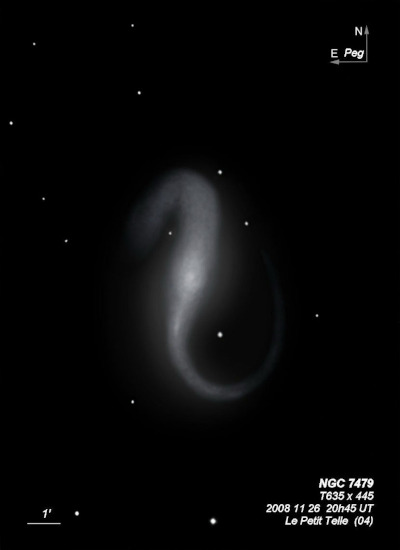
William Herschel discovered NGC 7479 = H I-55 = h2205 on 19 Oct 1784 (sweep 299) and noted "F, mE, r, near 3' in length and about 1' in breadth; I see 2 or 3 stars in it; but they do not seem to belong to it." On 23 Nov 1785 (sweep 476) he noted "cB, mE nearly in the direction of the meridian; about 4' long, about 2' broad, gbM." A sketch was published in 1811.
Lord Rosse or his assistant George Johnstone Stoney sketched NGC 7479 on 10 Sep 1849 (figure 4 in the 1850 PT paper). The sketch shows a single prominent spiral arm wrapping nearly completely back to the bar, though the form was uncertain: "Spiral, but query whether this is not more properly an annular than a spiral nebula." Tempel, John Herschel and d'Arrest made additional sketches.
In the 1900 paper "The spiral nebula H I 55 Pegasi" (1900ApJ....11....1K), Lick astronomer James Keeler compared the various sketches of NGC 7479 with the photograph taken with the Crossley reflector to demonstrate the subjectivity of sketches and their limitations compared to photographs.
300/350mm - 13.1" (9/29/84): fairly bright, elongated ~N-S. Strong impression of a dark lane or gap on the west wide and brief hints of haze beyond this gap, particularly around the south end towards the west (spiral arm).
13.1" (11/5/83): fairly bright, elongated N-S, bright core. Two faint stars are west and north.
400/500mm - 17.5" (7/19/90): this is one of few northern barred spirals in which the structure is clearly visible. A bright bar is oriented N-S with a bright core and nearly stellar nucleus. A mag 13 star is off the north edge 1.4' from center and a fainter mag 14 star is 47" SW of center. A thin curving spiral arm attached at the south end curves to the west and then north beyond the mag 14 star SW of the core. This arm parallels the bar along the west side about 90°. At the Sierra Buttes, the spiral arm was held almost continuously with averted vision. Located 3.3' NNE of a mag 10 star.
17.5" (10/12/85): thin curving arm clearly seen attached at the SW end curving to the north around a faint star.
900/1200mm - 48" (11/2/13, 10/30/16 and 10/28/19): The view of NGC 7479 was mesmerizing at 488x and 610x. Compared to the view last October, I noticed the fainter eastern arm was broader (split in two parallel branches on images) and although diffuse, obviously extended all the way to the southern edge of the galaxy, nearly reaching a mag 16 star. Also the bright arm on the western side of the bar dimmed as it extended north, but wrapped all the way or just beyond a mag 15.7 star situated 48" SW of the bright mag 12.5 star off the north end of the bar. The western arm clearly had a clumpy appearance with a couple of brighter patches. Near the south end of this arm [1.1' SSW of center] is a very faint quasi-stellar knot, which is catalogued as HII region #45 in Hodge and Kennicutt's 1983 "An Atlas of H II regions in 125 galaxies". Another brighter knot, ~12"x6", is at the southwest end of the arm [1.5' SW of center]. This is region #57 in the HK Atlas. A faint edge-on (V = 17.8), lies 3.5' NW of NGC 7479.
48" (10/22/11): NGC 7479 is probably the best barred spiral in the northern sky. At 488x and 610x the central bar appears very bright and extended over 2' N-S. The bar had a mottled appearance, bulging slightly in the center, was broadly concentrated with a small bright core. A bright mag 12.5 star is at the north end of the bar, 1.3' from the center.
At the northern end, an arm emerges from the bar and begins to curve counterclockwise to the east, but abruptly dims and merges with the halo on the east side. At the south end of the bar, a beautiful sweeping arm wraps counterclockwise around the south of a superimposed mag 13.5 star, extending to the west side of the core. This prominent arm dims and ends just north of an extremely faint HII knot (stellar) in the arm, which is catalogued as object #4 in Rozas' et al 1999 A&AS paper "Global properties of the population of HII regions in NGC 7479 from photometric H-alpha imaging". A mag 16.4 star is 0.7' due west (outside the arm) of this knot. A mag 15.7 star is also superimposed between the faint HII knot and the bright star at the north end.
Notes by Steve Gottlieb